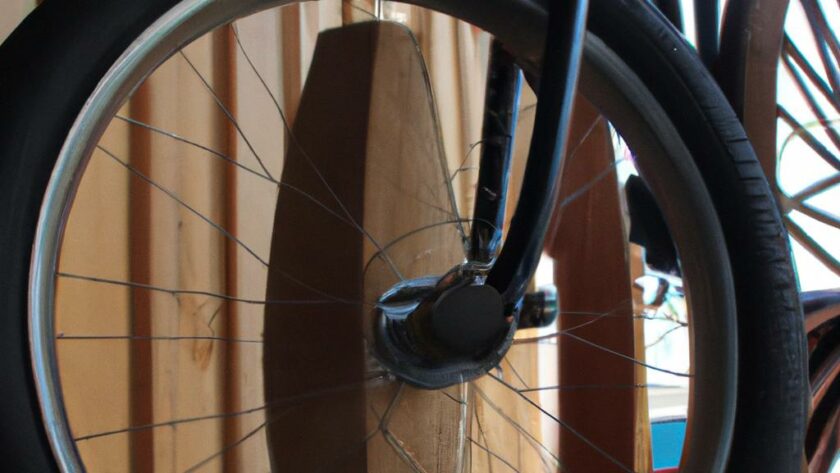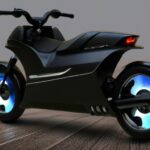Introduction: What Is an Ebike and How Does it Compare to a Traditional Bicycle?
An ebike, also called an electric bike, is a bicycle with a motor and a battery. The motor powers the bike forward and the battery provides energy to the bike motor. This makes cycling easier, faster, and more comfortable than cycling on a traditional bicycle.
The idea of an ebike has been around since the late 19th century, but it wasn’t until the 1990s that they began to become more widely available. They quickly made their way into the mainstream, and now there are many different types and styles of ebikes.
When comparing an ebike to a traditional bicycle, it’s important to consider both the advantages and disadvantages of each. Ebikes offer several distinct advantages over traditional bicycles.
- Ebikes are much easier to pedal than traditional bicycles due to the added motor power.
- Ebikes are often more comfortable to ride since they have adjustable seating and shock absorbing features.
- Ebikes usually have greater range and can get you further distances faster thanks to the motor.
- Ebikes are generally more versatile and come in many different styles, including mountain bikes, road bikes, city bikes, etc.
While ebikes offer some advantages over traditional bicycles, they also have certain drawbacks. These drawbacks include higher price tags and heavier frames. Ebikes also require more care and maintenance than traditional bicycles, given their more complicated design and components.
Ultimately, the decision to purchase an ebike or a traditional bicycle should be based on the individual’s needs and preferences. Consider all the pros and cons before making a decision and remember that both ebikes and traditional bicycles have their own unique benefits and drawbacks.
Are Ebikes More Expensive Than Traditional Bicycles?
Ebikes can range in price from a few hundred dollars to thousands of dollars! Generally, a good quality ebike is going to cost more than its traditional counterparts, but this cost difference is not as drastic as it may appear.
Basic ebikes can be quite affordable, often less than the cost of a higher-end traditional bike. However, if you are looking for bells and whistles, then the cost can definitely start to increase. As you add on more features and better quality components such as a stronger motor, more powerful battery and better brakes, the cost of an ebike will likely exceed the cost of a feature-packed traditional bike.
The good news is that ebikes can also be less expensive to maintain over time. Most ebikes come with fewer components that need servicing, so you won’t have to worry about frequent repairs or maintenance. The battery on most ebikes will also last longer than the batteries found on traditional bikes.
In addition to the monetary savings, investing in an ebike can also provide some serious health benefits too. Many ebikes offer riders the ability to adjust the power output of the motor, allowing them to ride at their own pace, no matter how tired they might get. This gives riders a great way to stay fit and active without having to sacrifice their comfort or safety.
Overall, ebikes can often be just as cost effective as traditional bicycles. You can find ebikes to fit all budgets, no matter how much you want to spend. The key is to determine what features and capabilities you want in an ebike and shop around to find the ones that meet your needs at a price that fits your wallet.
Exploring the Different Types of Ebikes
An electric bike, or ebike, is not just a regular bicycle with an added motor. There are actually many different types of ebikes that come in a variety of shapes and sizes.
The most common type of ebike is the pedal-assist bike. These bikes have a small motor powered by a battery that helps riders pedal up hills or against the wind. Other models have throttles that can propel the bike without the need for pedaling.
Ebikes also come in different frame designs. Mountain bikes are designed with sturdy frames and wide tires to tackle off-road trails. Road bikes are lightweight and streamlined for speed on paved surfaces like roads and bike paths. And folding ebikes are engineered to be compact and portable for easy transport or storage.
There are also ebikes tailored for specific needs. Cargo ebikes are great for carrying large loads such as groceries or passengers. And touring ebikes are built for long distances and feature racks for storing supplies.
Finally, there are e-scooters, which are electric scooters that are perfect for those who prefer a less physically demanding form of transportation.
No matter what type of ebike you’re looking for, there’s sure to be one to fit your needs. With so many different types of ebikes, there are plenty of options to choose from!
The Capabilities of Ebikes
Whether you are choosing to ride an ebike or a traditional bicycle, you need to understand the capabilities of each. An ebike is the perfect choice if you’re looking for power, speed, and convenience with minimal effort—it has several advantages over a traditional bike that make it ideal for commuting and trail rides.
One of the biggest advantages of an ebike is its motor-assisted power. This allows you to travel further in less time, meaning that you can enjoy longer rides without tiring out as quickly. The motor also helps to conquer hills and other difficult terrain with ease. And, because you don’t need to work as hard, your ride will be more enjoyable.
Ebikes are generally bigger, heavier and sturdier than traditional bikes. This means they can handle rough roads and off-road paths. Plus, they can often hold more weight than traditional bikes, and their larger size makes them better for cargo and carrying additional items around.
Additionally, ebikes are much faster than traditional bikes. Most electric motors can reach up to 25-30 mph, so you can get to where you’re going quicker and with less effort. Plus, you can recharge your ebike battery, so you don’t have to worry about running out of energy while you’re out on the road.
Finally, ebikes come with a variety of built-in features that make life easier. Most models have on-board computers, GPS systems, and built-in lights, plus many more features depending on the model you choose. This makes it easy to access important information, navigate new routes and stay safe during night rides.
Overall, ebikes offer all the benefits of a traditional bike, with the added convenience of motor-assisted power and enhanced features. With an ebike, you can ride further and faster, with fewer stops—and have more fun doing it!
Exploring the Components of an Ebike
Ebikes contain a variety of parts and components that help them function. It is important to understand what all the parts are and why they are important for achieving optimal performance from your ebike.
The main components of an ebike include:
- The frame – this is the bike’s structure, made from aluminum or steel. Depending on the type of ebike, the frame can range from rigid to full suspension.
- The motor – this is the heart of the ebike and is usually located in the front or rear wheel hub. It powers the bike, converting energy to motion.
- The battery – this part stores electricity and powers the motor. It can be removable or integrated into the frame.
- The speed controller – this part controls how much power goes to the motor and helps determine how fast the bike can go.
- The display – this part usually comes as a handlebar-mounted unit and displays various information such as speed, distance or power.
- The throttle – this is a type of accelerator that allows the rider to control their speed and power.
- Pedal assist – most ebikes have a pedal assist feature that adds extra power when pedaling, allowing the rider to travel faster and farther.
- Brakes – these are like traditional brakes and help you control your speed and stop the bike safely.
It is also important to note that there are other components in an ebike system such as the controller, charger, and wiring. These components work together to ensure the ebike runs smoothly.
Understanding the components of an ebike can help you make informed decisions when choosing the right ebike for you. It can also help you troubleshoot any issues that may arise during your ride.
Motor & Battery Technology: What Makes an Ebike Faster?
Ebikes are electric bicycles that are propelled by an electric motor and battery power. The motor and battery combination is what makes an ebike faster than a traditional bike, allowing riders to travel at greater speeds and increase their range by extending the time they can ride. As such, understanding the technology behind ebikes and how it affects speed and range is essential.
At its most basic, an ebike has a motor, battery and drivetrain that work together to propel it. The motor provides the power, while the battery stores and releases energy as needed. The drivetrain, which includes a chain and sprocket system, transfers the motor’s force to the wheels. When all of these components are combined, they create a powerful and efficient propulsion system.
The motor and battery on an ebike also contribute to the speed potential. Batteries come in a range of sizes, with larger batteries offering increased range and more power. Meanwhile, the type of motor used on an ebike will determine its peak speed. Hub motors are the most common type of motor found on ebikes, with brushless hub motors being the most powerful. Brushless hub motors can provide speeds of up to 28mph.
Finally, the software and electronics used to control the motor and battery play a big role in making ebikes faster. Advanced software and electronics allow riders to choose the best speed and power settings for their ride and customize the performance of their ebike. By adjusting the settings, they can maximize the efficiency of the motor and battery and increase the speed or range of the ebike.
In summary, motor and battery technology is the key factor in making ebikes faster than traditional bicycles. Understanding the components of an ebike and the capabilities of the motor and battery is essential to maximizing performance and tailoring the ride to the rider’s preferences.
Range Considerations for Ebikes
Range is an important factor to consider when looking at eBike choices. Choosing an eBike with the right range can allow you to ride farther and explore more areas than a traditional bicycle. The range of an eBike is determined by the battery capacity and the motor power. The higher the battery capacity and the more powerful motor, the longer the distance the eBike can travel on a single charge.
The range of an eBike is also determined by how much energy is used during riding. If a rider pedals lightly or does not use extra features such as lights, the battery will last longer. The terrain that the rider is traveling on also plays a role. If a rider is climbing steep hills or going up against strong headwinds, this can require more power from the motor, which can reduce the range of the eBike.
When choosing an eBike, it is important to look for models that offer the right range for your needs. If you plan to ride mainly on flat terrain, then a smaller battery size and less powerful motor might be enough to get you where you need to go. But if you need to climb steep hills or travel long distances, then it is important to invest in an eBike with a larger battery capacity and a more powerful motor.
It is also important to take into account the charging times of the eBike you are considering. Some eBikes can take over five hours to completely recharge the battery, while others can take as little as two hours. This should also factor into your decision when comparing different brands and models of eBikes.
Speed Considerations for Ebikes
When considering an electric bike, the speed of the bike is one of the most important features. Electric bikes can be incredibly fast, allowing riders to accelerate quickly, travel long distances in a short amount of time, and reach top speeds of 25-30 mph.
However, speeds can vary greatly depending on the type and model of electric bike you choose. Many electric bikes have adjustable speed settings, allowing you to tailor your experience depending on what type of ride you are looking for. Additionally, the motor size and battery capacity will play a large role in the maximum speed achievable with your ebike.
For example, an electric mountain bike may have more powerful motors than other types of ebikes and will typically reach higher speeds. On the flipside, low-power electric bikes that use smaller motors and batteries may have a maximum speed of around 20 mph.
Another factor to consider when it comes to speed is the terrain you plan to ride on. If you plan to ride in areas with steep hills, it is important to make sure your ebike has enough power to get up them. Most electric bikes will be able to climb hills as long as the gradient isn’t too steep.
Finally, it is important to consider local laws and regulations when it comes to the speed of your electric bike. In many countries, there are restrictions on the maximum speed of ebikes, so make sure you familiarize yourself with the laws in your area before riding.
By taking the time to consider all the factors that affect an electric bike’s speed, you can make sure you find the right bike for your needs and ensure a safe and fun riding experience.
Road Safety Tips for Those Who Ride Ebikes
Riding an ebike is a great way to get around, but it’s important to make sure you’re doing it safely. Here are some tips to help you stay safe if you’re planning on using an ebike:
Wear Protective Gear
It’s essential that you wear appropriate safety gear when riding an ebike. This includes a helmet, gloves, and padding for your elbows and knees. Wearing this gear can help protect you from serious injury if you fall or have an accident.
Be Familiar with Road Rules
Before you take your ebike out on the road, be sure that you understand your local road rules for cyclists. Things like speed limits and where you can ride an ebike can vary from place to place, so make sure you’re up to date on what applies to you.
Use Proper Lighting
If you plan on riding your ebike at night, make sure you’re equipped with front and rear lights. These will help other drivers and cyclists see you, making it safer for you and those around you.
Check Your Tire Pressure
Before going out on an ebike ride, make sure to check that your tires have the correct amount of air in them. Low tire pressure can cause your ebike to be less stable, particularly on wet surfaces, putting you at risk of an accident.
Understand Your Ebike’s Battery Capacity
Make sure that you know your ebike’s battery capacity so that you don’t run out of power in the middle of your ride. If you plan on taking a long ride, make sure your battery is fully charged before leaving.
Stay Alert
No matter what type of bike you’re on, it’s vital that you stay alert and aware of your surroundings while riding. This means keeping an eye out for cars, cyclists and pedestrians, as well as obeying all traffic laws.
Following these tips will help to keep you safe while you’re out on the road with your ebike. Remember to ride responsibly, have fun and stay safe!
Benefits and Drawbacks of Riding an Ebike
Riding an ebike has its own pros and cons depending on the type and style of biking you are wanting to do. When it comes to the environment, an ebike can help reduce your carbon footprint, because you are using electricity instead of gasoline. You also have more control over your speed when you are riding an ebike as you can adjust your power setting on the fly. Depending on the terrain, you may have an easier time on an ebike than on a traditional bike as well due to the motor providing just the right amount of assistance.
On the other hand, ebikes can be heavier than regular bicycles and can require more maintenance. The extra weight can also make it difficult to store or transport your ebike. They also come with more expensive batteries and motors, which can add up depending on how often you plan to use your ebike. Additionally, if you are looking for a more intense workout when you ride, an ebike may not provide enough challenge as the motor helps you along.
Finally, riders should be aware of the laws related to ebikes in their area. In most states, ebikes are considered motorized vehicles and must follow the relevant regulations. This includes registration, licensing, and speed restrictions as well as age-based requirements. As such, riders should familiarize themselves with the local laws before hitting the roads.
Conclusion: Is an Ebike Faster Than a Traditional Bicycle?
Ebikes offer a number of advantages to traditional bicycles, including better speed and range. But how much faster is an ebike compared to a bike?
The answer to that question depends largely on the type of ebike you’re riding, the terrain you’re riding over, and the rider’s experience level. Generally, a properly equipped and maintained ebike can reach speeds of up to 28 mph, while traditional bicycles typically only reach speeds of up to 18-20 mph. This can make a huge difference when it comes to long-distance rides or races.
The battery technology incorporated into most modern ebikes also contributes to its potential for fast speeds. Electric motors are capable of providing increased power and torque, which can result in faster speeds. Additionally, ebikes are often able to tackle steep inclines with ease and can even explore off-road terrain that would be too difficult for a traditional bicycle.
One thing to remember, however, is that the speed of an ebike is only as good as its rider. Knowing how to properly maintain and control your ebike is just as important as the technology behind it. With the right knowledge and technique, even a novice rider can enjoy greater speeds on their ebike.
In conclusion, an ebike can definitely be faster than a traditional bicycle if used in the right setting, but it is ultimately up to the rider to make use of the technology. With the right techniques and maintenance, any rider can experience the thrilling power and speed of an ebike.
FAQs About Ebikes
In recent years, electric bikes or ebikes have become increasingly popular. Many people are curious about these new modes of transportation, but they may not know where to begin when it comes to finding out more information. That’s why this section is devoted to answering some of the most common questions people have about ebikes.
Q: How does an ebike work?
A: An ebike uses a rechargeable battery to power an electric motor, which helps propel the bike forward. The battery is typically located in the frame of the bike, and can be easily recharged when needed. Depending on the model, some ebikes also feature a throttle that can be used to manually increase your speed.
Q: Do ebikes require a license?
A: It depends on the laws in your area. In some places, ebikes may need to be registered and you may be required to have a driver’s license or special permit to operate them. It’s always a good idea to check with your local government before buying an ebike.
Q: What are the benefits of riding an ebike?
A: There are many benefits to riding an ebike instead of a traditional bicycle. For one thing, you don’t have to worry about pedaling up hills or long distances, since the electric motor will provide the necessary assistance. Plus, you can usually get farther and faster on an ebike than you would on a traditional bike. Finally, some ebikes come with built-in features like lights, cargo racks, and even phone holders that make it easier to use your ebike for commuting, running errands, or just having fun.
Q: Are ebikes safe?
A: With the right safety precautions, ebikes can be relatively safe. Make sure to wear a helmet at all times when riding your ebike, and be aware of your surroundings. Check your brakes often, and keep the battery charged to ensure your motor is working properly. If you follow these tips, you should be able to enjoy your ebike safely.
FAQs About Ebikes
- Q: What is an ebike?
A: An ebike is a type of bicycle that is powered by a motor and a battery. It is designed to provide the rider with a boost of power, making it easier to pedal for distances and up hills. - Q: Are ebikes more expensive than traditional bicycles?
A: Yes, generally ebikes are more expensive than traditional bicycles, as they come with additional accessories, such as the motor and battery. The cost of an ebike will also depend on the type of motor, battery and other accessories that are included. - Q: What are the different types of ebikes?
A: There are various types of ebikes available, including mountain ebikes, street ebikes, commuter ebikes, fat tire ebikes, cargo ebikes, folding ebikes and recumbent ebikes. - Q: What are the capabilities of ebikes?
A: Ebikes have the capability of providing additional levels of assistance to the rider by providing a power boost for cycling. This additional boost makes it easier to cycle for longer distances, or up hills, and increases the level of assistance provided when tackling difficult terrain. - Q: What components make up an ebike?
A: The components that make up an ebike include the frame, motor, battery, brakes, wheels, tires, gears and handlebars. These components work together to provide an efficient and comfortable ride. - Q: What technology makes ebikes faster?
A: Ebikes use motor and battery technology to provide power to the cyclist. The motor can provide a boost of power that can assist in travelling at higher speeds, while the battery helps to store the power and make the ride more efficient. - Q: Is an ebike faster than a bike?
A: An ebike has the potential of being faster than a traditional bicycle as it uses motor and battery technology to provide a power boost for riding. However, the speed of an ebike will depend on the type of motor and battery used, as well as the terrain being ridden.
comments: 0




